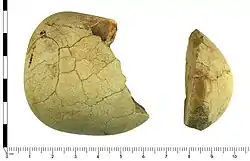Pot boiler
In archaeology or anthropology, a pot boiler is a heated stone used to heat water - typically by people who did not have access to pottery or metal vessels.

In Archaeology
The term refers to a stone used to move heat from a fire to a vessel to raise the temperature of water in the vessel, including for cooking. The stone is heated in a fire or in embers. When hot enough, the stone is transferred into a vessel of water to heat the contents. The vessel may be metal (though this is uncommon, metal normally being tough enough to take direct heat from a fire) or pottery which is not of good enough quality to be directly exposed to the heat of the fire[1] - or a wooden trough.[2] In a pre-pottery context, the heating can be done by lining a pit with leather, leaves or clay, and then putting in the water followed by pot boilers directly into the vessel.[3][4]
Such stones can be recognized because the repeated exposure to the heat of the fire followed typically by rapid chilling in water leads to great thermal stress on the stone's fabric due to the thermal expansion and contraction. This typically leads to partial glazing of the stone's surface and a fine network of cracks on the stone's surface (often described as "crazing"). Eventually the stone shatters. Individual fragments may be re-used until it becomes infeasible to manipulate the stone into and out of the fire, at which point the fragments are discarded and a new pot boiler (or many new ones) are acquired. Often the broken pot boilers are discarded into middens or domestic waste deposits, which on long-established sites can amount to many tonnes of material.[2]
Reuse as building material is not impossible, but the typical small size of the fragments hinders this use.
Identification
Surface "crazing" is not restricted to pot boilers - hearth stones and the surrounds of fireplaces may also show the same structure. However, since a pot boiler needs to be manipulated into and out of the fire (typically in anthropological observations, using sticks of green wood) at arm's length, they start off weighing up to several kilogrammes, and shrink by fragmentation ; hearth stones and chimney liners are typically larger.
See also
References
- Johnson, Walter (1908). Folk-memory: or, The continuity of British archaeology. Clarendon Press. p. 112.
The hearth fire has handed down one relic of antiquity, the ' pot-boiler '. The pot-boiler was a roughly rounded stone, usually flint, which was made red hot and then flung into the water contained in the primitive cauldron or in a puddled hollow in the soil. By this means flesh was boiled, however inefficiently. Or, again, the meat was grilled or baked over the heated stones. The use of the pot-boiler for heating water was continued until late in the historic period.
- "Record ID: FAKL-19038D - BRONZE AGE pot boiler". The Portable Antiquities Scheme. Retrieved 2018-04-17.
- "Pot Boiler stone , Mesolithic". www.futuremuseum.co.uk Dumfries Museum & Camera Obscura. Retrieved 2018-04-17.
- "Neolithic (Stone Age) Pot Boilers | UKGE". www.ukge.com. Retrieved 2018-04-17.